Stage racing requires a whole new level of commitment, preparation and suffering to mountain biking. But it also delivers the most lasting memories and rewarding experiences you are likely to ever have on a bike. To guide you through what can be a formidable entrance to multi-day events, we got TREAD’s stage race guru, Nic Lamond to put together this advice. He’s done more stage races than he can remember and also got in touch with some of the ABSA Cape Epic riders that have done all 11 editions to add some of their wisdom. – By Nic Lamond

BIKE TYPE
The most critical part of any bike adventure is the bike itself – without it, quite simply, you’re hiking. We are spoilt for choice when it comes to solid well-priced stage-race machinery capable of handling mountain terrain and delivering you to the finish line each day with a smile on your dial.
But the best bike for the job is the one you have. If you own a mountain bike and have just a couple of grand for an upgrade, don’t even get sucked into the wheel size debate. Rather spend the money on ensuring your bike fits you perfectly, is reliable and runs as safely and smoothly as possible. And that your clothing is comfortable, but we’ll get to that later…
A professional bike fit, servicing your fork or shock, fitting new tyres and the replacing of worn out parts of your drivetrain or brakes will bring a tired old bike to life. This is especially true when buying second hand – keep a little bit of cash in hand for these strategic renovations.
Your race machine needs to be trustworthy. As one of only six 11-time finishers of the Absa Cape Epic, John Gale points out: “You need to be lucky on a repeat basis to survive the Epic. Health, personal and work circumstances, the bike – everything has to hold together long enough for you to get to the finish. You need to be lucky, and you need to avoid ‘bad’ luck.” Stack the deck by riding a well-maintained bike.
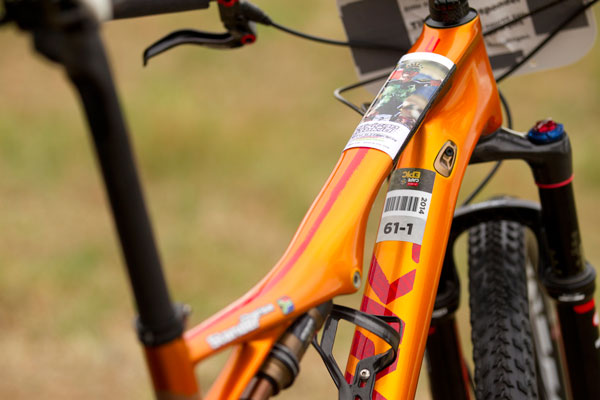
If you’re in the market for a new rig, first understand what type of riding you enjoy and where you will spend the bulk of your time in the saddle. Then jump on a scale. Lastly, take a good hard look at your budget. Remember that the 65-kilo pro mountain biker on an obscenely light carbon masterpiece probably has a full-time mechanic to keep the bike perfectly dialed-in. And he’s not putting nearly the same kind of strain on the bike to get on the podium as you are to place in the top-50 in the TREAD Buffalo Category. Not only that but pros aren’t paying for the continual replacement of high-end parts that bolt to the bike.
It is argued that you should start out on a hardtail to develop a better riding technique, but who’s got time for that? If you intend exploring a number of South African stage races and you can afford it, buy a full-suspension bike. We live in a stunning country, but the most spectacular parts of it are pretty inhospitable. That means rocks, steep descents and rough trails. Simply put, you will be able to ride for longer and in relative comfort on a dual-sus. However, not all full-suspension mountain bikes are created equal. Subtle differences in geometry, shock position and pivot points can create marked differences in how a bike handles. So test as many bikes as you can before you drop your loot.
Most South African stage races aren’t technical, that is, they don’t require highly advanced bike handling skills to complete. If you don’t agree, I don’t recommend signing up for any stage races in the French Alps or British Columbia in Canada. Our races generally favour open trails and longer distances. As a result there is an overriding case for the 29-inch wheel size in South Africa.
If you’re short (1.65m or less), or your local trails are tight and technical you might want to consider the 27.5-inch version. And the more rowdy you like to get when trail riding, the more travel you should consider. If you actively seek out challenging lines, steep drops and love being airborne look for more than 120mm of front and rear travel. It may not be the most efficient way to complete a stage race, but you’ll have a bigger smile than the herd crossing the finish line with you.
Ultimately though, the ideal stage race bike for most South African events is a 29-inch wheel, full-suspension bike with 100mm of travel up front, 80–100m of travel at the rear (with suspension adjustability). Check out the four good stage race bike options we reviewed in the Gear section of this issue for more insight. Stage Race Bikes: CHOOSE YOUR WEAPON
TRAINING
If, like us, you’re lucky enough to have a group of mates who enjoy riding as much as you do, you’ll never ‘train’ a day in your life. Training will simply be a byproduct of hanging out together. However, when building up to a stage race, it’s best to simulate some of the riding conditions you will encounter during the event. This could include mixing in different weather, longer distances and new terrain. Don’t forget to practice fixing potential mechanical issues you may not face on your regular ride.
As a start, for shorter stage races, you want to be absolutely sure you can pedal anywhere from four to eight hours a day for three days in a row. The aerobic fitness to tackle a stage race is your first hurdle. When the thought of doing that no longer petrifies you, start targeting some of your perceived weaknesses, such as steep, technical climbing or flats – basically any parts of your mountain biking repertoire where your mates out-ride you. Build challenges into your regular riding that allows you to progress the areas of your riding that need work.
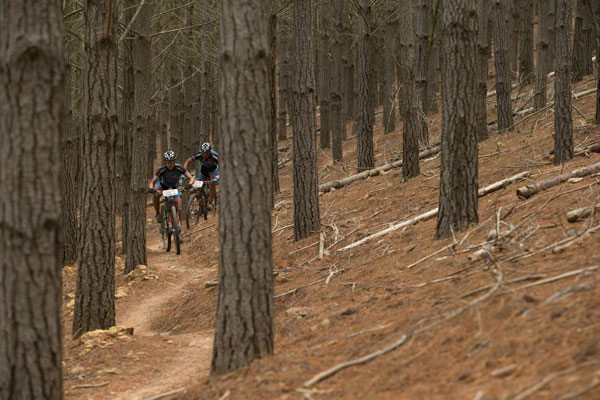
For longer stage races it’s a little different. The task of riding your bike for eight or nine days back-to-back is not to be underestimated. The strain on your body is compounded and niggles that you might be able to push through over three days, become serious issues over five or six.
“You have to put in good quality hours on the bike, including lots of climbing and technical sections,” says Handrik van Huyssteen, another of the Absa Cape Epic’s Amabubesi Club members who have done all 11 events. “Say, a minimum of 15 hours per week on average for 12 weeks. We normally have a couple of 20-plus-hour weeks as well.”
“To ride one’s own bike is such a privilege,” admits a nostalgic Craig Beech, another 11-year Absa Cape Epic legend, when asked about training. “We are part of an amazing sport, an amazing lifestyle, it coagulates so many important life aspects. To have the health to ride, to have the ability, the time, all of that is enjoyment in itself. But, perhaps, a way of reducing the suffering ‘then’ is to allow a little more suffering ‘now.’”
Technical skills development is the most neglected aspect of training. Yet it is just as essential as getting fitter. We are all guilty of getting into a routine – a favourite trail or riding group – that no longer demands us to push ourselves. When that happens we can often be caught out when the pace is higher or the route throws weather or trail conditions at us that we’re not used to.
One way to improve your skills is to ride with people who are better than you. This could include paying a skills coach for a few instructive sessions. It is amazing what pearls you will walk away with after even a few hours with a good coach. Trust us, even the best riders in the world get coached, they just won’t admit it!
You could also attend a TREAD Skills Clinic, where you’ll be shown in a safe, professional, progressional manner, how to tackle basic, intermediate and advanced trail and race route obstacles.
TRANSPORT
Getting your bike (and all your riding paraphernalia!) to and from stage races can be more daunting than the event itself. No matter how generous event organisers are with complimentary kit bags, they are invariably roughly half the size you require.
There are a couple of professional businesses in the market now specialising in taking care of mountain bike stage racing logistics for you. Bike transport companies, often linked to a local bike shop in your hometown promise to have your fully assembled race bike ready for collection at race registration. Other full-service operations exist that will take care of everything: flights, accommodation, transport, massages, bike maintenance and more…
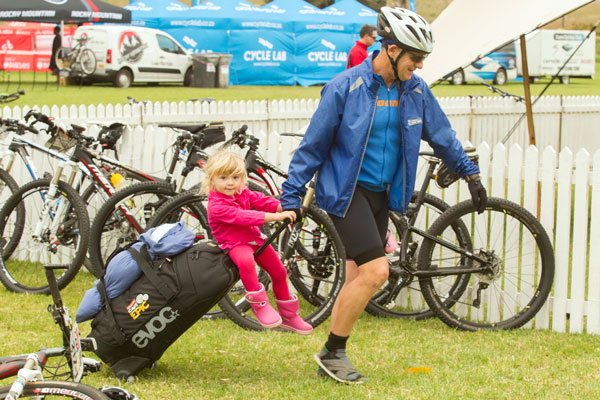
If you choose to travel with your bike on a local or international commercial flight, do your research. Some airlines charge exorbitant fees for sporting equipment, while others are happy to take your bike box for free. Either way, use the lightest, most robust bike box you can afford and buy an industrial roll of bubble wrap for packing your precious cargo. Or, if you can afford it, invest in a high-quality bike bag/box that will probably outlast you… If the stage race you are signed up for requires you to bring your own bedding, it can be handy to pack it in your bike box, between parts that might scratch or bang into each other. Be sure to pay particular attention to the seat post and rear derailleur areas, they are the most prone to damage from over-zealous baggage handlers.
CLOTHING AND GEAR
What you wear on a stage race should be just as important as what you ride. Poorly designed or worn-out race apparel can completely destroy the experience of riding the blinged-out carbon Christmas present you gave yourself.
This applies across the board: bibs, shorts, jerseys, gilets, rain jackets, arm warmers, gloves, socks, shoes, helmets and hydration pack – all need to, at a minimum, be snug and fill you with confidence that they’re more than up to the weather conditions expected out there. It doesn’t have to be the latest season’s colours or imported from Italy, it just needs to work. In fact, a worn-in pair of bibs, or shoes, is the way to go. New isn’t always better.
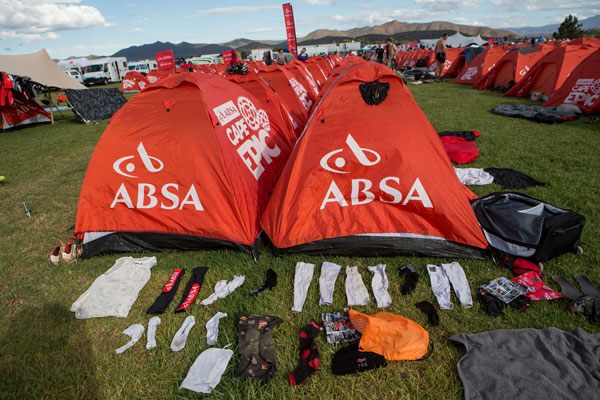
In our experience, two sets of kit (bibs and jersey) is plenty to survive a three-day stage race in comfort. Take some biodegradable washing powder into the shower with you and scrub your kit after Day 1. Sorted. For an eight or nine day race, with the same approach you can get away with three sets, but four is preferable. I have one rule when it comes to kit that I never compromise on – new socks every day! There is nothing worse than putting on soggy socks in a pre-dawn tent. It can kill your whole vibe.
TYRES
Tyre choice is the fastest way to divide a group of seasoned mountain bikers. Because we can’t all change our tyres with the regularity of World Rally Championship drivers we want a tyre that is robust yet offers reliable cornering and traction in a variety of weather conditions. And because of how critical tyres are to enjoying our ride, everyone has a favourite – certain brands create downright raging fans.
Our advice is simple. Go tubeless. And get reinforced tyres. Tubes are for the birds. And for the vast majority of South African conditions you want a puncture protection sidewall to guard against sharp rocks. Sure, there’s a weight penalty to pay for the extra rubber used to line the tyre, but the time you’ll save from not having to stop to fix punctures is a no-brainer.
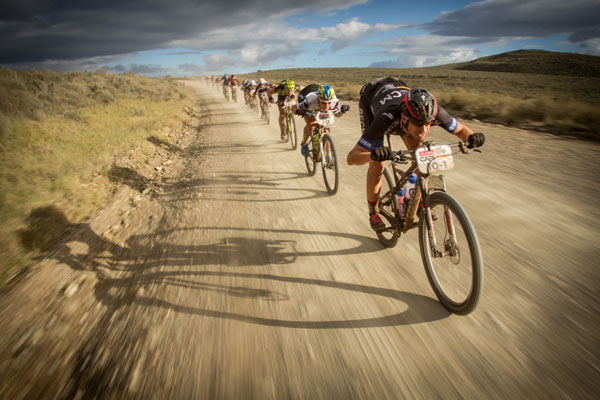
Tread pattern is a matter of preference and often has more to do with where a rider does most of their regular riding as well as what they’re familiar with. However, there are a few things to consider. Rolling resistance is important. You want a tyre that doesn’t create too much friction as it makes contact with the ground, as this can slow you down on smoother or more open trails. But low rolling resistance often means smaller knobs on the tyres, and less control when cornering. A good compromise is to have a low-profile tyre on the rear of the bike, and a bigger, more aggressive tread pattern tyre on the front. When it gets really wet, an open tread pattern will allow the tyre to shed mud or dirt faster. Keep one of these tyres on hand if the weather gods aren’t playing along.
One of the greatest improvements you can experience in your tyre’s performance is to inflate it to the correct pressure – and it’s a lot lower than you think. This is the beauty of tubeless technology, it allows us to run really low tyre pressure – some of the lighter and more skilled pro riders are known to run their tyres at just over 1 bar! Lower pressure allows the tyre to grip better. The enhanced handling on steep climbs and in corners can be staggering. Obviously, if your tyre pressure is too low, you run the risk of bottoming out your rim on rocky terrain or burping (rolling the tyre off the rim) on sharp corners. Experiment.
GEARING
The advent of 10- and 11-speed drivetrain systems, that now allow us to ride a single front chainring, has led to an obsession with gearing. Should I stick with a 2×10 drivetrain or convert to a 1×11? Am I strong enough to ride a 34T front chain ring?
Both 2×10 and 1×11 setups have pros and cons. The reality is that unless you are training on exactly the same course, with the same gradient climbs in the same weather conditions you will never know whether your gearing is adequate. In a stage race your job is to prepare for all the variables. A drivetrain with more gears, gives you more choice, and you can respond to more variables in the weather, race route or your health. So stick to a 2×10. If your bike comes with a 1×11 set-up, stick with a 32T front ring (or smaller).
ENERGY FOOD
We believe you should keep it simple. Find natural high-energy foods that are palatable and easy to eat on the bike. We’ve found natural ingredients are easier to digest, and can be eaten regularly over a number of days. There are plenty of bars and gels available that fit the bill. But if you’re looking for other options bananas, dried fruit, nuts, biltong and pitted date bars (like the kind you use for cooking) are our suggestions.
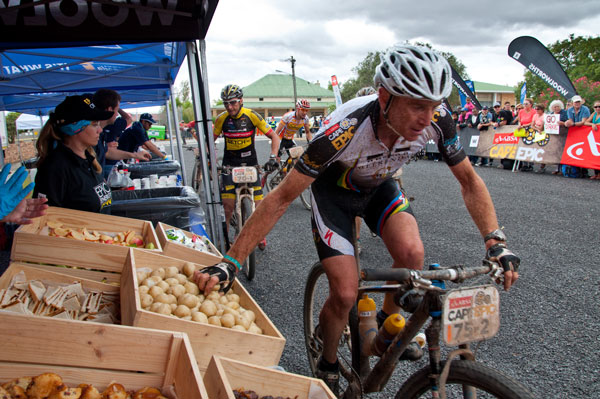
The only woman to have completed all 11 Absa Cape Epics to date is Hannele Steyn. She understands that her diet is a critical part of her success. “My motto is ‘be prepared’. Your training preparation and your nutrition are both crucial and in an eight-day event, you cannot survive without either of these two.”
Hannele believes you should use your training days to experiment with the foods you are going to eat in the saddle, to make sure they are a sustainable option for eight days. She adds, “You can do [the Absa Cape Epic] on little training, Coke and Bar Ones and a R5 000 bike, but you asked me what advice can I give to someone to enjoy the Epic.”
SPARES
Most stage races have a number of local bike shops in attendance to service bikes and offer expert mechanical support should you have to deal with any major problems. That said, they can’t be expected to carry enough spares to service the entire field, especially the riders with an exotic brake system or hand-made frame. Make sure you bring any spares unique to your bike – whether it’s an old or rare brake pad or rear derailleur hanger.
During the race carry all the basic equipment necessary to repair and inflate a slashed tyre, put in a new tube, fix a broken chain and tighten a loose bolt. We also recommend carrying a spare tyre valve – it’s a small item to pack but a faulty valve has race-ending potential. Lastly, pack a few spare zip ties and some duct tape, wrapped around your seat post or frame. If it can’t be fixed with zip ties and duct tape, it isn’t worth keeping.
PARTNER
Not all stage races require you to team up with a riding partner to compete. But many mountain bikers consider this to be the heart of stage racing – an opportunity to share a once-in-a-lifetime connection while traversing the natural beauty of the outdoors.
Don’t be fooled by the nostalgia. Managing somebody else’s hopes, fears and expectations over the course of a stage race both intensifies the camaraderie and amplifies your differences. And if the relationship is strained it can sap you of all the energy you need to stay upright on the bike. You need to find a partner who respects you, has endless patience and is not afraid to communicate. Foundations similar to those of a solid marriage! Yet the most important ingredient in the perfect partnership is you. You need to possess the very same traits you’re looking for.
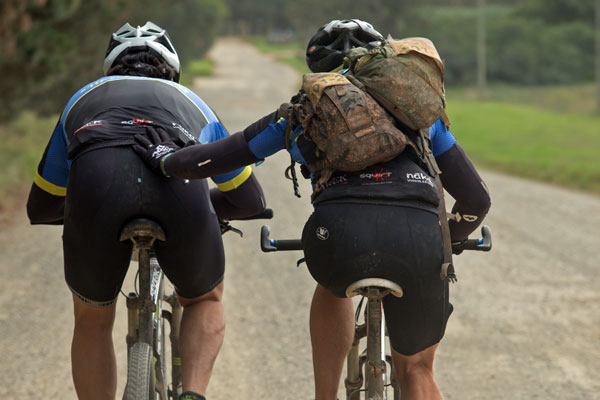
Over to veteran stage racer Hendik van Huyssteen again: “The right partner is not one that wants to race you into the ground all the time. Or even compete with you. I see it so often – one partner tries to show the other who is the strongest and wants to tell his friends his partner could not keep up. Stay away from those partners.” Indeed, the right partner is one you want to help, but aren’t afraid to lean on if the going gets tough.
TREAD Magazine is sold throughout South Africa and can be found in: Spar, CNA, Exclusive Books, Discerning bike shops and on Zinio
*Originally published in TREAD Issue 33, 2015 – All rights reserved



